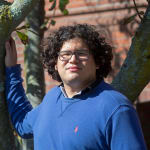IceCube collaborator and Harvard physics professor Carlos A. Argüelles-Delgado is the recipient of a 2021 IUPAP Young Scientist Prize in Astroparticle Physics. Young Scientist Prizes recognize the contributions of early career physicists within the subfields of each commission of the International Union of Pure and Applied Physics (IUPAP). The accolade consists of a certificate, medal, […]
News
Week 25 at the Pole
Let’s start with the food. Last week at the Pole, they were frying up donuts—using a Paul Hollywood recipe from “The Great British Bake Off.” They made almost 70 (!) of them, because, you know…donuts. During the week, the IceCube detector had been fairly quiet. The winterovers take turns getting paged to deal with detector […]
Week 24 at the Pole
Finally, midwinter has arrived! Midwinter is widely celebrated across Antarctica, not just at the South Pole, and has many traditions, including exchanging gifts and sharing a lavish meal. This year at the Pole, the theme for the festivities was 1920s prohibition, with dress and decorations to match, and with a “secret” bar—winterover Josh served as […]
Week 23 at the Pole
Relatively quiet from the previous week has changed to relatively busy for last week at the Pole. To start with, the winterovers participated in not one but two outreach webcasts. But they also had their hands full with detector activity, having to deal with various computer crashes and other issues on top of regularly scheduled […]
Week 22 at the Pole
A relatively quiet week it was, last week at the Pole. As far as the IceCube detector goes, quiet is good. There are always regular maintenance tasks and occasional issues that require troubleshooting, but nothing that hinders its performance. The detector has maintained a very high uptime over its many years of operation. And that’s […]
Week 21 at the Pole
Last week (well, on May 26), there was a rare super blood moon event—the coinciding of a supermoon, when the moon is at its closest to the Earth, and a blood moon, when the moon turns red as it enters Earth’s shadow during a lunar eclipse. The eclipse was only visible in parts of the […]
IceCube looks for low-energy neutrinos from gravitational wave events
Ever since the first detection of gravitational waves by LIGO and Virgo, the IceCube Neutrino Observatory has been searching for neutrino counterparts to gravitational waves. Detecting both gravitational waves and neutrinos from the same source would be a groundbreaking step in multimessenger astronomy, the field that uses multiple kinds of cosmic messengers to see the […]
Week 20 at the Pole
It was relatively quiet last week at the Pole. There were auroras, though, which gave winterover Martin a chance to take some great outdoor photographs. He walked out to the satellite dish domes with one of the communication engineers on station. This is Martin’s second stint as an IceCube winterover, but on his first time […]
Week 19 at the Pole
It’s night at the South Pole—dark skies all the time, no sunlight for months—but that doesn’t mean there is no light. Last week, IceCube’s winterovers found clear skies with enough light from the stars and auroras overhead that they didn’t need to rely on their headlamps as they made their way to the IceCube Lab […]
Week 18 at the Pole
Some people love to camp out in tents. But outside at the South Pole? Not sure how many takers there would be for that. Last week, however, intrepid IceCube winterover Josh willingly spent the night in a tent pitched outside the South Pole station’s main entrance. Looks like he rested peacefully, as shown below. Above, […]









